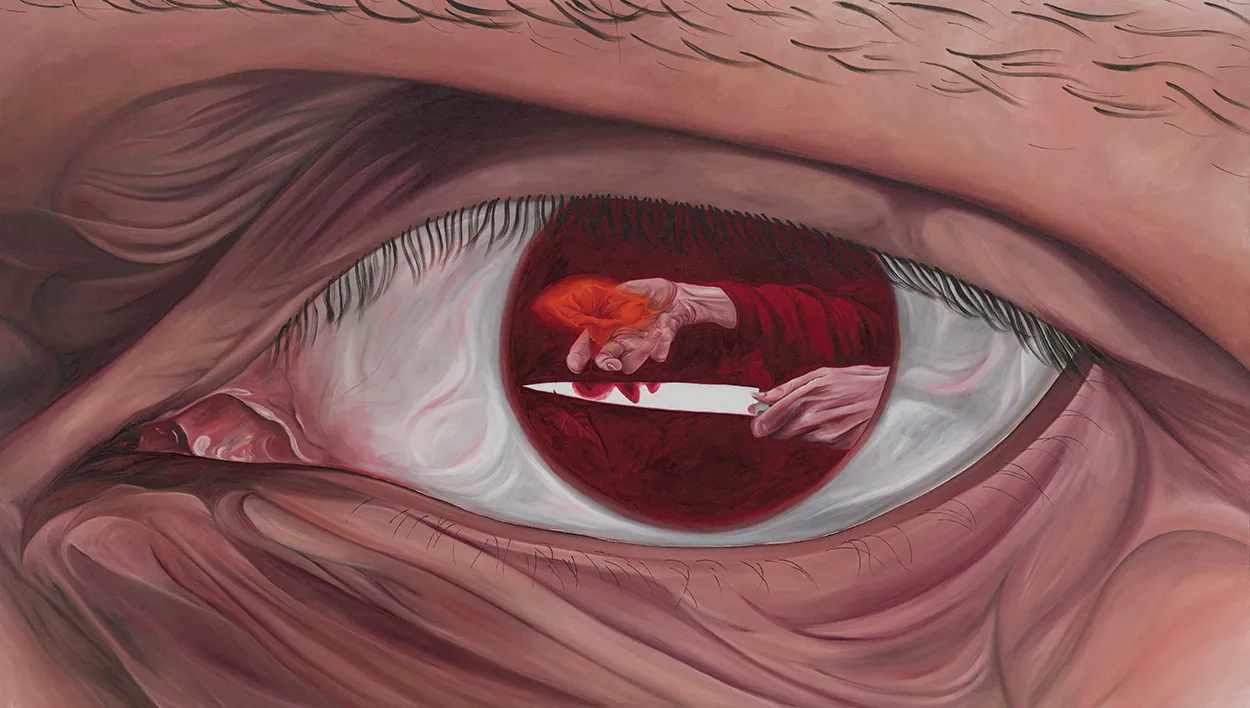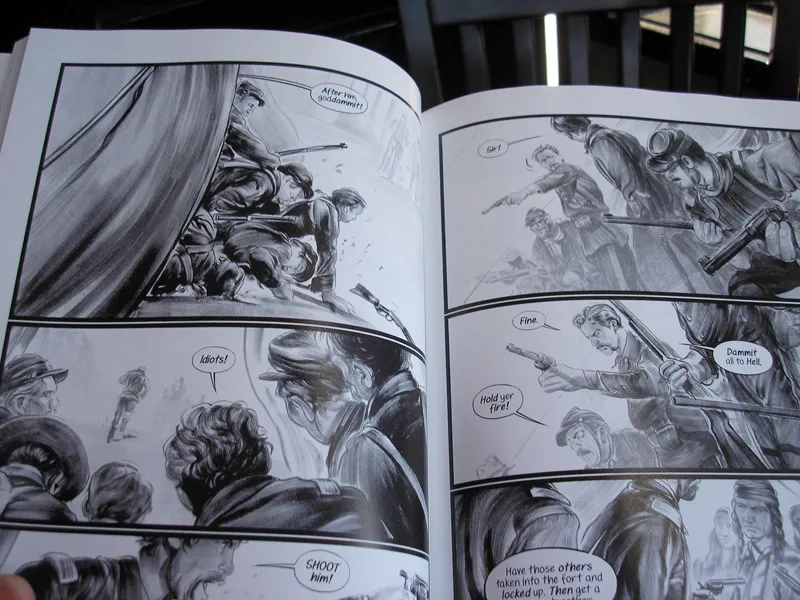Ethan Hawke’s graphic novel, Indeh: A Story of the Apache Wars, dives into the brutal conflict between the Apache people and the United States government in the late 19th century. Illustrated by Greg Ruth, the narrative transcends a simple portrayal of war, offering a poignant exploration of cultural clashes, the horrors of violence, and the enduring human cost on both sides.
A Glimpse into the Apache Struggle: Loss, Resilience, and the Cry of “Indeh”
The story unfolds through the eyes of Naiche, son of the legendary Apache leader Cochise, and Geronimo, another prominent figure in the resistance movement. The year is 1872, and the Apache way of life is under siege. Forced from their ancestral lands and facing relentless military campaigns, the Apaches fight for survival.
The narrative opens with a defining moment for Naiche. Witnessing the brutal massacre of his family, he experiences a vision urging him to lead a retaliatory strike against a Mexican village. This act, fueled by grief and vengeance, sets the tone for the harsh realities of war. The haunting Apache word “Indeh,” meaning “the dead,” becomes a recurring motif, echoing the constant loss and sacrifice endured by both sides.
Geronimo, a seasoned warrior, embodies the resilience of the Apache spirit. He leads daring raids and escapes, refusing to surrender despite facing overwhelming odds. Through his experiences, we see the strategic brilliance and unwavering bravery of the Apache warriors, who knew their land intimately and used guerilla tactics to great effect.
Beyond Battlefields: Cultural Clashes and the Erosion of Trust
Indeh doesn’t shy away from depicting the atrocities committed by both sides. The graphic illustrations portray the brutality of warfare, from the devastation inflicted upon Apache villages to the violence inflicted on settlers and soldiers. However, the story goes beyond mere depictions of violence. It delves into the root causes of the conflict, highlighting the cultural clashes and misunderstandings that fueled the flames of war.
The Apaches viewed the land as sacred, a crucial element of their way of life. For them, forced relocation meant not only losing their homes but also severing their connection to their ancestors and their spiritual practices. The American government, however, saw Apache resistance as an obstacle to westward expansion and viewed their nomadic lifestyle with suspicion.
The graphic novel indeh depicts several historical figures who attempted to bridge the divide, such as General George Crook, who advocated for peaceful coexistence. However, their efforts are ultimately overshadowed by those who sought dominance and fueled the cycle of violence. Broken treaties and failed negotiations further eroded trust between the two sides, leading to a seemingly endless conflict.
Dual Narratives: Witnessing the Conflict Through Apache Eyes
Hawke’s storytelling approach is particularly noteworthy. He utilizes dual narratives, allowing readers to experience the conflict through the eyes of Naiches and Geronimo. Naiches, a young warrior yearning for revenge after witnessing the massacre of his family, embodies the simmering anger and despair felt by many Apaches. Geronimo, a seasoned leader who has witnessed the devastating consequences of war, embodies the yearning for peace and the struggle for his people’s survival.
Naiches’ Journey: A Path of Wrath and Loss
Naiches’ narrative is marked by a burning desire for vengeance. Haunted by the brutal murder of his loved ones, he represents the frustration and anger of a generation forced to bear the brunt of the conflict. His path is one of violence and bloodshed, a stark reflection of the brutal realities of war.
Geronimo’s Burden: Seeking Peace Amidst Turmoil
Geronimo, on the other hand, embodies a more pragmatic and cautious approach. He recognizes the futility of prolonged resistance and the devastating cost it inflicts upon his people. His narrative underscores the weight of leadership, the difficult choices inherent in war, and the constant struggle to balance survival with dignity.
By presenting these contrasting perspectives, Hawke avoids romanticizing the conflict. He compels readers to confront the complexities of the situation, the understandable anger on both sides, and the tragic consequences of war.
Artistic Expression: Haunting Imagery and Storytelling Through Panels

Greg Ruth’s Artwork: A Powerful Visual Narrative
The graphic novel is brought to life by the evocative artwork of Greg Ruth. His stark and haunting imagery captures the raw emotions of the characters, the desperation of war, and the vastness of the Apache homeland. The use of black and white panels, with occasional bursts of color for impactful moments, creates a powerful contrast and emphasizes the emotional weight of the story.
Panel Composition and Storytelling
Ruth masterfully utilizes panel composition to advance the narrative. Wide-angle panels depict the vastness of the Apache territory, while close-up panels showcase the raw emotions on the characters’ faces. He cleverly utilizes contrasting imagery, juxtaposing peaceful landscapes with scenes of violence, highlighting the devastating impact of war on the environment and the Apache way of life.
The interplay of text and visuals in the graphic novel format allows for a unique and compelling storytelling experience. The artwork itself conveys a wealth of information, capturing cultural details, the warriors’ attire, and the impact of war on the landscape.
Beyond the Battlefield: Indeh Explores the Human Cost
The Emotional Toll of War
“Indeh” transcends a mere historical account. It delves into the emotional toll of war, showcasing the psychological trauma inflicted on both sides. Both Naiches and Geronimo are haunted by their experiences, grappling with loss, survivor’s guilt, and the struggle to maintain hope in the face of relentless violence.
The Weight of History
The graphic novel indeh also delves into the broader historical context of the conflict. It exposes the broken promises and broken treaties made by the U.S. government, highlighting its role in fueling the Apache Wars. The graphic depiction of atrocities committed by both sides serves as a potent reminder of the enduring legacy of violence and the importance of acknowledging historical injustices.
The Human Cost: Scars on the Soul and the Search for Peace
The human cost of the Apache Wars is a central theme in Indeh. Through the characters of Naiche and Geronimo, we witness the emotional and psychological toll of constant warfare. Naiche grapples with guilt and vengeance, forever haunted by the loss of his family. Geronimo, despite his bravery, experiences the weariness of a long struggle, yearning for peace and a chance to rebuild his life.
The narrative delves into themes of leadership, loyalty, and the enduring bonds of family and community. The Apaches, despite their internal differences, unite against a common enemy. The graphic novel humanizes the soldiers on both sides, portraying their fear, exhaustion, and the trauma inflicted by constant fighting.
The story ultimately offers a glimmer of hope. The later chapters touch upon the eventual surrender of Geronimo and the forced relocation of many Apaches to reservations. While acknowledging the harsh realities of their defeat, the narrative doesn’t portray surrender as a complete loss. It hints at the possibility of healing, of holding onto cultural identity even in the face of adversity, and of seeking a path toward a future where the cries of “Indeh” can finally fade away.
A Legacy of Indeh: Learning from the Past, Recognizing the Pain
Indeh is more than just a historical account of the Apache Wars. It serves as a powerful reminder of the consequences of cultural clashes and the devastating impact of war on human lives. By exploring the perspectives of both sides, the graphic novel encourages readers to engage with a complex and often-overlooked chapter in American history.

The use of graphic art allows for a powerful visual representation of the historical events. The stark black and white illustrations emphasize the brutality of the conflict and the emotional turmoil of the characters. The narrative provides historical context but prioritizes human experience, allowing readers to connect with the characters and understand the human dimension of the war.
A Complex Web of Alliances and Shifting Loyalties
The Apache Wars were not a monolithic conflict. Different Apache bands held varying perspectives on resistance, and alliances with other indigenous groups like the Chiricahua and Navajo added layers of complexity. indeh navigates this complexity, showcasing the internal debates within Apache communities and the occasional cooperation with other tribes facing similar threats. The narrative also acknowledges the presence of Apache scouts who served with the U.S. Army, highlighting the difficult choices individuals faced during this turbulent period.
The Role of Media and Public Perception
The graphic novel sheds light on the role of media in shaping public perception of the conflict. Newspapers and illustrations often portrayed the Apaches as savage and bloodthirsty, further demonizing them in the eyes of the American public. indeh challenges these narratives, showcasing the humanity and strategic thinking of the Apache warriors. Newspapers of the time often relied on sensational headlines and inaccurate depictions, fueling public anxieties and justifying military actions against the Apaches.
FAQ
This FAQ explores the core themes, characters, and historical context of Ethan Hawke’s graphic novel, “Indeh: A Story of the Apache Wars.”
Core Themes: Cultural clashes, broken treaties, war’s brutality, vengeance, survival, and the search for peace.
Main Characters:
- Goyahkla (Geronimo): A young Apache warrior seeking revenge.
- Cochise: A revered Apache leader advocating for peace.
- Naichees: Cochise’s son torn between loyalty and vengeance.
- General Crook: A U.S. Army leader with a more nuanced understanding of the Apache.
- General Howard: A ruthless military commander.
Historical Period: 1872-1886, a critical period in the Apache Wars.
Accuracy: While fictionalized, “Indeh” is heavily researched and depicts real figures and events.
Art Style: Detailed and gritty, portraying war’s harshness, Apache landscapes, and character emotions.
Age Appropriateness: Mature audiences or those with parental guidance due to violence and war themes.
Finding “Indeh”: Bookstores, online retailers, and libraries.
Further Exploration: Museums, historical societies, online resources (National Archives, Smithsonian Institution), and films like “Apache” (1954) or documentaries like “The Apache Wars” (2009).

